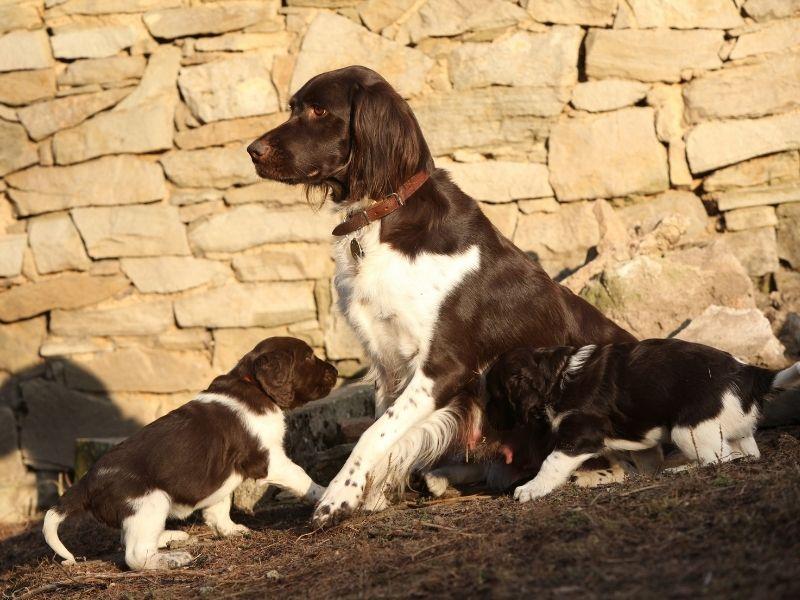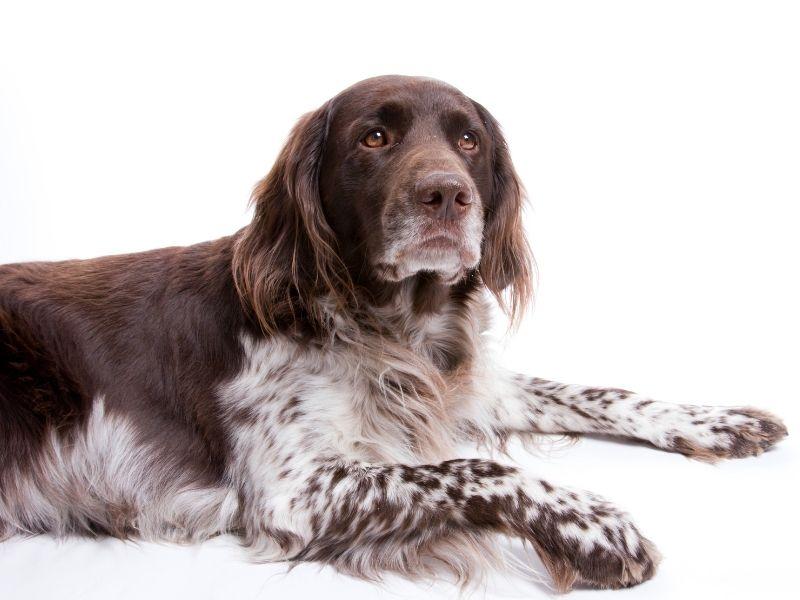The Small Munsterlander Dog breed is a hunting dog that was bred in the early 1800s in Germany. They are known for their intelligence, energy, and ability to hunt both large and small game. This clever, energetic breed can be used as an all-purpose hound and is particularly good at trailing game without getting lost or confused.
According to the American Kennel Club, the Small Munsterlander was developed from a dog brought from Germany in 1812. It is believed that they were used to hunt wolves in southern Germany and Switzerland. These dogs are quite independent and can be aloof with strangers.
The breed was historically used for hunting all over Europe, including France, Belgium, Italy and Spain. This breed is still used today as a hunting dog primarily in northern Europe although numbers have dropped significantly in recent years.
What Dog Breed Is the Small Munsterlander?
The Small Munsterlander dog breed is categorized under Working Dogs and Hounds by the American Kennel Club. Their name refers to the place where they were bred – Munster, Germany. They were originally used for hunting wolves and other large game. Today, they are still used for hunting, but their prey has changed to include rabbits, grouse and other small game.
This breed has a long, low-slung body that has a well-developed chest. The head is small and triangular in shape with large floppy ears. The muzzle is narrow with long tufts of hair coming off the tip of the nose. The eyes are set close together and are oval-shaped.
The coat of the Small Munsterlander is medium, thick and wavy, and sheds seasonally. It’s most commonly a solid color, chestnut, or white, with dark patches, and an undercoat. The coat can also be black or a combination of colors.
The fur is quite dense and feels silky to the touch. The hair on the muzzle, tail, and back of the legs is longer than on other parts of the body.
The fur is thick and the dog has a large bushy tail. The Small Munsterlander has a layer of thick undercoat that provides insulation in the cold. The fur allows the dog to move quickly over the land and hunt in various climates.
The ears are long and triangular in shape, broad at the base, hanging close to the head. The eyes are brown with a friendly expression and dark eyebrows. The teeth should be white with black lips. The teeth themselves help keep prey from slipping through the dog’s mouth when it is tearing at it.
The breed is usually solid white with a black mask that extends down the cheeks. The coat color should be as described above, but can also include black, fawn or tan patches.
What Is the Difference Between a Large and Small Munsterlander?
The difference between the Small Munsterlander and Large Munsterlander is simply the size of the dog. The Small Munsterlander is smaller at a shoulder height of about 18 to 20 inches; and weighs between 35 – 50 lbs. The Large Munsterlander has a shoulder height of 21 to 24 inches; and weighs 45 – 60 lbs.
The type of coat on each breed is also different. The Small Mun has a long, thick and silky coat that is waterproof. The Large Mun coat is not quite as long or as thick.

What Living Conditions Are Best for a Small Munsterlander?
The Small Munsterlander dog breed is at home in most climates. They are active dogs that require plenty of physical activity, both indoors and outdoors. The breed makes a great family dog for an owner that can give the dog the attention it needs to be happy and well-adjusted to its surroundings.
The Small Mun can be a good apartment dweller but should have space to run and play outdoors. They are energetic dogs that need plenty of room to roam around when they aren’t working.
How Much Exercise Does a Small Munsterlander Need?
This breed is a hunter, so it’s important that it gets exercise daily. The Small Munsterlander’s favorite activity is running around, playing and chasing birds. These dogs need at least 60 minutes of daily exercise along with plenty of mental stimulation.
How Old Is the Small Munsterlander when it is Potty Trained?
The Small Munsterlander is an eager learner that responds well to positive training methods. They learn very quickly if they’re given lots of praise and exercise while they are young.
It can be possible for a young Small Munsterlander to be house trained by 4-6 months old. The training process will take very little time at this age and the dog will learn what needs to be done in no time.
See Also: Are Small Dog Breeds Good Pets?
And: What are the Most Popular Breeds of Spaniel?
Is a Small Munsterlander a Spaniel?
The Small Munsterlander is not a Spaniel. It is categorized in the Hound Group of dogs by the American Kennel Club. The scenting ability of the Munsterlander was developed for hunting, so it’s not a retriever or spaniel but rather a hunter.
What to Feed a Small Munsterlander Dog?
According to the Small Munsterlander Club of America, the breed prefers a high-quality dry food. They should be fed a portion of this food twice daily. The amount of food that is fed should be adjusted depending on the dog’s activity level and exercise routine.
When Can a Small Munsterlander Go on a Diet?
The Small Munsterlander is classified by the American Kennel Club as an active breed. This means they should stay in shape by running and playing regularly. They should not be fed a diet that’s high in carbohydrates but rather one that is higher in protein. A diet high in protein helps to maintain a healthy weight for the breed.
Are Small Munsterlanders Smart?
This breed is an exceptional problem solver and is always looking for something to do. They have the intelligence to learn quickly but need plenty of exercise in order to stay out of trouble. The intelligent mind of this breed makes them a good companion dog or hunting dog if their owner gives them the attention they need and allows them to play and run often.
What Is a Small Munsterlander’s Lifespan?
The Small Munsterlander has a lifespan of 12-15 years when properly cared for.
Conclusion
Overall, the Small Munsterlander is a friendly, faithful dog that makes an excellent companion. They are commonly used as hunting dogs thanks to their great sense of smell and eagerness to please. They are easy to train when their owners are sensitive to their needs and provide plenty of positive reinforcement and exercise.
It’s important to keep this breed active as they tend to get depressed if left alone for long periods of time. This breed is also good for families with children because of their good disposition and affectionate nature.
Featured image: Small Munsterlander Dog

